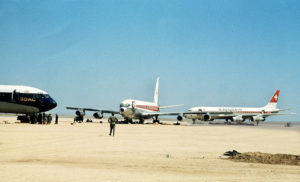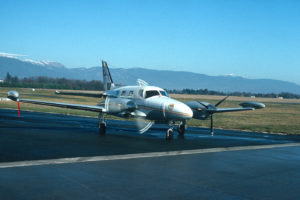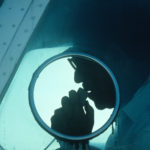The world was changing faster than at any time since the Six Day War. In November 1989 the Berlin Wall crumbled, marking the end of the Cold War. I was an associate editor of Hors Ligne, a glossy magazine for air charter travellers. Its publisher, Geneva entrepreneur Pio Fontana (1939-2005), had co-founded with flight instructor Ernst Saxer Aeroleasing (ALG). Europe’s largest air taxi service,

ALG specialised in exfiltrating important people from delicate situations. In September 1970, the People’s Front for the Liberation of Palestine (PFLP) hijacked three airliners – a Swissair DC-8, a TWA Boeing 707 and a BOAC VC10 – to an abandoned airfield at Zarqa in Jordan. As negotiations for the release of the 431 passengers, aircrews and airliners, were engaged, ALG’s Saxer flew to Zarqa with an executive jet to expatriate the Swissair pilots upon their release. As it turned out, the hostages were evacuated by road to Amman, but the three airliners, worth millions, were blown up.

Nine years later Geneva attorney Bruno Keppler, a Hors Ligne director, acquired a half-interest with ALG in a Piper Cheyenne twin-engine turboprop. ALG held by then the European distributorship for Pipe Aircraft. In addition to the pilot, a Cheyenne can carry up to five passengers. With its avionics and cabin configuration, the Cheyenne resembled a baby airliner. The ALG-Keppeler Cheyenne was registered under the call letters HB-LLK.
Keppeler had obtained his law degree from the University of Geneva, a doctorate in law from the University of Madrid, and a comparative law degree from the International Law Academy at The Hague. I had met him some years before when he was a lead member of IOS-founder Bernie Cornfeld’s defence team. Fontana asked that I take part in the Malaysian International Air Race as a HB-LLK crewmember – i.e., the official scribe. Keppeler was pilot.

The Air Race – more properly an Air Rally – was from Paris to Singapore and back. The 13 participating aircraft were flagged off from an airfield six miles SW of Paris on the first Monday of February 1990. The contestants had to fly without incident a total of 25,000 km (15,535 miles) through the airspace of 21 countries, with six fixed layovers. I was reluctant to go as I had fallen madly in love with a Swiss druggist, Lucia Kaeppeli, and didn’t want to be away from her for a whole month. But as it was a work assignment I had no choice. HB-LLK’s co-pilot was Pierre Lainey, a dental surgeon from Rouen.
Our first night was at Bahrain. Next overnight stop was Dhaka. When we reached the Malaysian resort island of Langkawi we learned that Frederik de Kierk had released Nelson Mandela from 27 years of imprisonment and promised an end to apartheid. We also learned that Germany’s reunification had been approved and would be effected later in the year. What was the modern world coming to? Gorbi – Mikhail Gorbachev – with his call for perestroika (restructuring) had set in motion a political tsunami that was unstoppable.
During the Air Race, Bruno, confided his lifelong dream was to fly around the world by the Great Circle Route across Siberia. He had filed several requests with the Soviet civil aviation authority but was always rebuffed. I mentioned that I knew a senior Soviet diplomat in Geneva who might be able to help. Officially Vladimir Chebanov was listed as a Tass News Agency correspondent, but I suspected he was really a KGB agent.
Bruno agreed it was worth a try. Once back in Geneva I contacted the ever-affable Chebanov and suggested the three of us have lunch. He listened intently to Bruno’s proposition and said he would contact his superiors in Moscow. Days later the Soviet civil aviation authority requested that Bruno submit a flight plan. On 9 April 1990 ALG filed a detailed flight plan for LLK. Next day an acceptance landed on the desk of ALG’s chief dispatcher, but with certain provisos attached – the original routing had to be modified to avoid over-flight of the Kamchatka Peninsula, and from Moscow onwards the flight had to be operated with a Soviet navigator aboard. Bruno was ecstatic. A third proviso was that the authorisation was limited in time and had to be acted upon within a few days. Bruno scheduled departure for Saturday, 14 April, the day before Easter.
Bruno’s wife Sheila was in Montego Bay, Jamaica, where she owned a seaside condominium. Bruno had promised to join her after Easter, meaning that he now had to fly around the world to get there. As a surprise, he planned to bring Lena Ligonnet, Sheila’s close friend from Chamonix, France, with him. Since I had provided the contact that made the flight possible, he insisted I join them. I thought the idea splendid but explained that my heart belonged to Lucia. “That’s wonderful,” Bruno replied. “You must bring her with us.”

